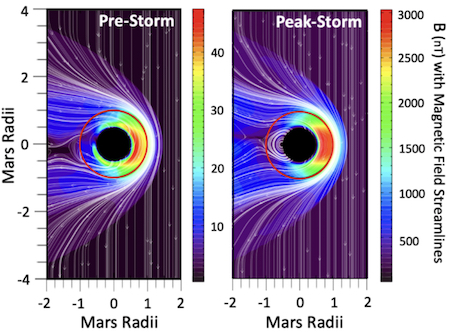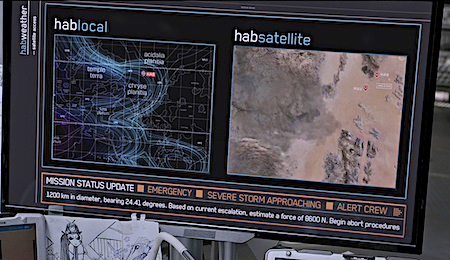Science Fiction
Dictionary
A B C D E F G H I J K L M N O P Q R S T U V W X Y Z
Mars Space Weather Alert (MSWA) System

A Mars Space Weather Alert (MSWA) system would take a comprehensive approach to providing information to astronauts on the surface of Mars, as well as those going to and from the planet.
A recent paper by James L. Green, Chuanfei Dong, Michael Hesse, C. Alex Young, Vladimir Airapetian details how an MSWA system might be approached. (SF writers have already contributed the phrase space-weather men, which might be applied to these researchers.)

(The modeled Martian responses to an extreme Carrington-type
SW event before (A) and at the peak of the solar storm (B))
Space weather observations and modeling at Mars have begun but they must be significantly increased to support the future of Human Exploration on the Red Planet. A comprehensive space weather understanding of a planet without a global magnetosphere and a thin atmosphere is very different from our situation at Earth so there is substantial fundamental research remaining. It is expected that the development of suitable models will lead to a comprehensive operational Mars space weather alert (MSWA) system that would provide rapid dissemination of information to Earth controllers, astronauts in transit, and those in the exploration zone (EZ) on the surface by producing alerts that are delivered rapidly and are actionable.To illustrate the importance of such a system, we use a magnetohydrodynamic code to model an extreme Carrington-type coronal mass ejection (CME) event at Mars. The results show a significant induced surface field of nearly 3000 nT on the dayside that could radically affect unprotected electrical systems that would dramatically impact human survival on Mars. Other associated problems include coronal mass ejection (CME) shock-driven acceleration of solar energetic particles producing large doses of ionizing radiation at the Martian surface.
In summary, along with working more closely with international partners, the next Heliophysics Decadal Survey must include a new initiative to meet expected demands for space weather forecasting in support of humans living and working on the surface of Mars. It will require significant effort to coordinate NASA and the international community contributions.
(From Space Weather Observations, Modeling, and Alerts in Support of Human Exploration of Mars.)
Science fiction fans can't wait. They've been getting hints about the idea of space weather systems for at least the last eighty years. Most recently, fans were treated to a beautifully realized storm on Mars in The Martian, a 2015 film directed by Ridley Scott from the excellent 2011 novel by Andy Weir.
(Storm scene from The Martian [2015])
In the film, the storm center is envisioned on several screens:

(Weather central - The Martian movie edition)
As far as I know, the earliest descriptions of "space weather" in science fiction are in The Storm by legendary sf writer A.E. van Vogt.
On the three-dimensional map at weather headquarters on the planet Kaider III, the storm was colored orange. Which meant it was the biggest of the four hundred odd storms raging in the Fifty Suns region of the Lesser Magellanic Cloud...
(Read more at space weather map)
Scroll down for more stories in the same category. (Story submitted 10/29/2022)
Follow this kind of news @Technovelgy.| Email | RSS | Blog It | Stumble | del.icio.us | Digg | Reddit |
Would
you like to contribute a story tip?
It's easy:
Get the URL of the story, and the related sf author, and add
it here.
Comment/Join discussion ( 0 )
Related News Stories - (" Space Tech ")
Will Space Stations Have Large Interior Spaces Again?
'They filed clumsily into the battleroom, like children in a swimming pool for the first time, clinging to the handholds along the side.' - Orson Scott Card, 1985.
Reflect Orbital Offers 'Sunlight on Demand' And Light Pollution
'I don't have to tell you about the seven two-mile-diameter orbital mirrors...'
Chrysalis Generation Ship to Alpha Centauri
'This was their world, their planet —
this swift-traveling, yet seemingly moveless vessel.' - Nat Schachner, 1934
The First Space Warship For Space Force
'Each of the electrical ships carried about twenty men...' - Garrett P. Serviss, 1898.
Technovelgy (that's tech-novel-gee!) is devoted to the creative science inventions and ideas of sf authors. Look for the Invention Category that interests you, the Glossary, the Invention Timeline, or see what's New.
Science Fiction
Timeline
1600-1899
1900-1939
1940's 1950's
1960's 1970's
1980's 1990's
2000's 2010's
Current News
Natural Gait With Prosthetic Connected To Nervous System
'The leg was to function, in a way, as a servo-mechanism operated by Larry’s brain...'
Woman Marries Computer, Vonnegut's Dream Comes True
'Men are made of protoplasm... Lasts forever.'
Spidery 'Walk Me' Toyota Autonomous Wheel Chair Like Star Wars
Walk along with the emperor.
Dancing Robots Taught Dance Moves
'A clockwork figure would be the thing for you...'
Proof Of Robothood - Not A Person
'Who are you people? - Show 'em.'
Indonesian Clans Battle
'The observation vehicle was of that peculiar variety used in conveying a large number of people across rough terrain.'
The 'Last Mile' In China Crowded With Delivery Robots
Yes, it's a delivery robot. On wheels.
Tornyol Microdrone Kills Mosquitoes
'The real border was defended by... a swarm of quasi-independent aerostats.'
PLATO Spacecraft, Hunter Of Habitable Planets, Now Ready
'I ... set my automatic astronomical instruments to searching for a habitable planet.'
Factory Humanoid Robots Built By Humanoid Robots
'...haven't you a section of the factory where only robot labor is employed?'
iPhone Air Fulfils Jobs' Promise From 2007 - A Giant Screen!
'... oblongs were all over the floor and surfaces.'
ChatGPT Now Participates in Group Chats
'...the city was their laboratory in human psychology.'
iPhone Pocket All Sold Out!
'A long, strong, slender net...'
Did The Yautja Have These First?
What a marvel of ingenuity the little device was!
Jetson ONE Air Races Begin, Can Air Polo Be Far Behind?
'If you're one of those rarities who haven't attended a rocket-polo "carnage", let me tell you it's a colorful affair.'
Will Space Stations Have Large Interior Spaces Again?
'They filed clumsily into the battleroom, like children in a swimming pool for the first time, clinging to the handholds along the side.'
